Service Alert
July 1 - Canada Day
CELA will be closed on Tuesday, July 1st for Canada Day. Our office will reopen and our Contact Centre services will resume on Wednesday, July 2nd. Enjoy your holiday!
CELA will be closed on Tuesday, July 1st for Canada Day. Our office will reopen and our Contact Centre services will resume on Wednesday, July 2nd. Enjoy your holiday!
Showing 1 - 20 of 9331 items
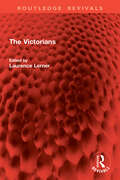
By J. W. Burrow, Barry Supple, Laurence Lerner, Carol Dyhouse, Geoffrey Hemstedt. 1978
First published in 1978, The Victorians presents a survey of the Victorian era, exploring the relationship between literature and society…
through three distinct sections. The first delineates the literary history in two chapters on the Victorian novel and Victorian poetry respectively. In the second and largest section of a series of essays discuss various fundamental aspects of Victorian society: the economic and social framework, government and institutions, the sense of the past, painting and illustration, religion and the role of women. The third section offers two essays which explicitly relate a particular work to the society: one on Dicken’s Dombey and Son and the other on Tennyson’s The Princess. By turning to each essay after the rounded picture of Victorian society given in the previous section, the reader will not only find her appreciation enhanced but will also be enabled to argue back on equal terms in a way that is never possible with the survey of literature alone. This book is a must read for scholars and researchers of English literature.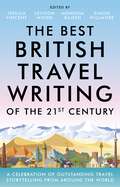
Travel writing mattersExplore the world through this beautiful collection of the finest travel writing published in British media in the…
21st century - as judged by some of the most respected travel writers in the world: Levison Wood, Monisha Rajesh, Jessica Vincent and Simon WillmoreThe world has changed, but our desire to explore new places remains as strong as ever. The Best British Travel Writing of the 21st Century includes 30 outstanding travel stories published in British media over the last two decades, as chosen by some of the top names in travel writing today. Through travel's most talented storytellers, you'll face adversity along the Congo's raging River Lulua, make new friends aboard Iraq's night train, and embark on life-changing pilgrimages from India to Saudi Arabia.This book is an ode to travel and all that it offers, but it's also a celebration of a genre that brings the world closer to us. At its best, travel writing encourages empathy and inspires change. Join our award-winning writers in marvelling at the power and beauty of travel, and let them inspire you to fall in love with the world all over again.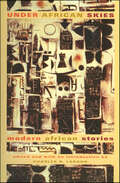
By Charles R. Larson. 1997
Spanning a wide geographical range, this collection features many of the now prominent first generation of African writers and draws…
attention to a new generation of writers. Powerful, intriguing and essentially non-Western, these stories will be welcome by an audience truly ready for multicultural voices.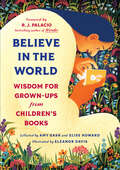
By Amy Gash, Elise Howard. 2024
An inspiring and delightful illustrated collection of quotations from a diverse range of our most beloved children's books that will…
help teach all of us how to live in the world today, perfect for gift season and for readers of books like The Boy, The Mole, The Fox, and The Horse and How to Love the World. Everything we need to know as adults can be found in the brilliant, imaginative, diverse world of children's books. That is the simple yet powerful promise that Believe In the World offers. This illustrated, gifty collection, with witty and inspirational quotations organized in chapters such as "How to Believe in the World" and "How to Have Fun in the World," reminds us not to lose sight of the values we learned as kids—to be courageous, to do good deeds, to respect our imaginations, and maybe even to break a few rules every once in a while. Some quotations will bring readers back to old favorites like The Little Prince or Ramona Forever while others will lead to new discoveries inspired by the exciting new variety of children&’s books being published today. And all provide a roadmap to doing and being good in the world. As one reviewer wrote about Believe In the World's predecessor, What the Dormouse Said, published by Algonquin in 1999, &“Whether you&’re looking for wisdom about goodness or sadness or even more practical matters, you will surely find it in this delightful collection.&”Believe In the World lands in the sweet spot of nostalgic and entertaining; fresh and enlightening. And at the same time, it reminds us of the exhilaration of being a reader, young at heart, venturing forth into the world of storybooks and unforgettable characters and confirming that we are never too old to recapture the lessons, pleasures, and exuberance of childhood.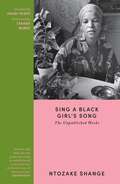
By Ntozake Shange. 2023
I am gonna write poems til I die and when I have gotten outta this body I am gonna hang…
round in the wind and knock over everybody who got their feet on the ground. In the late 1960s, Ntozake Shange was a student at Barnard College discovering her budding talent as a writer, publishing in her school's literary journal, and finding her unique voice. By the time of her death in 2018, she had scorched blazing trails across countless pages and stages, redefining genre and form as we know them, each verse, dance, and song a love letter to Black women and girls, and the community at large. In Sing A Black Girl's Song, we meet the young Shange, learn the moments that inspired for colored girls who have considered suicide/when the rainbow is enuf, travel with an eclectic family of musicians, and sit on "The Couch" opposite Shange's therapist. We read, in their original form, the literary rebel's politically charged verses from the Black Arts Movement era alongside her signature tender rhythm and cadence that capture the minutia and nuance of Black life.This new posthumous collection, including never-before-seen unpublished essays, plays, and poems, is a long-lasting gift from this seminal Black feminist writer, one of the fiercest and most highly celebrated artists of our time.EDITED BY IMANI PERRY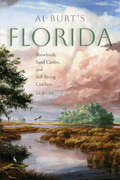
Florida Trust for Historic Preservation Award Florida Historical Society Patrick D. Smith Florida Literature Book Award A tour of twentieth-century…
Florida through the writing of a roving reporter"Some say that Floridians lack a sense of place—they won’t after reading Al Burt."—Ann Henderson, Former executive director, Florida Humanities CouncilAs a roving reporter for the Miami Herald from 1973 to 1995, Al Burt traveled all of Florida, studying it with the insight of a native and the detached eye of the foreign correspondent he had been. During those years, he observed connections with the state’s past and speculated about its future, and, while he was at it, took note of the human frailties and heroisms he witnessed every day. Al Burt's Florida is like a family portrait, a loving but not uncritical view of a complex and fascinating state.Burt's portrait combines vignettes of notable Floridians—some famous at the time, like Ed Ball, but most better known locally—with those of the state’s many special places: Okeechobee in the teens and twenties, Miami Beach in the fifties (when dinner in Havana was only a $26 plane ride away), Wakulla Springs when it served as Johnny Weismuller’s Tarzan movie set, modern-day Tallahassee with its formality and grace.Al Burt himself emerges from this landscape as the remarkable, engaging, and passionate Floridian he is. He takes us in hand, starting from his headquarters in the north Florida scrub, on a tour of the charm, substance, and fantasy of Florida, yesterday and today. And always, he dwells with greatest affection on the smaller places, the real places, the anchors of old Florida—and on those folks who do their best to preserve them. In the process he captures a sense of Florida as home.A volume in the Florida History and Culture series, edited by Raymond Arsenault and Gary R. Mormino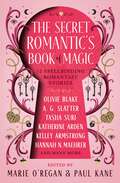
By Kelley Armstrong, Melissa Marr, Paul Kane, Marie O'Regan, Megan Bannen, Tasha Suri, A. G. Slatter, A. C. Wise, Olivie Blake, Eliza Chan, Hannah Nicole Maehrer. 2025
Enemies become lovers, rivalry turns to romance, and convenient marriages create true love in these 12 addictive Romantasy tales. Featuring…
Olivie Blake, Kelley Armstrong, Katherine Arden, Hannah Nicole Maehrer, Tasha Suri, Melissa Marr and more.Fall in love with these twelve gorgeous Romantasy stories from bestselling and beloved authors.Lost lovers return for a second chance – but what are their motives? Academic rivals compete for a prestigious position, but their sizzling chemistry might get in the way. A monster slayer posing as an unwitting sacrifice meets an intriguingly moral prince.From relationships caught in disparate timelines to ghostly ballrooms and dragons that need rescuing from princesses, this anthology gives you an inventive new spin on all your favorite tropes, and much more that you&’ve never seen before.FEATURING BRAND-NEW STORIES FROM:Olivie BlakeA. G. SlatterTasha SuriKatherine ArdenKelley ArmstrongHannah N. MaehrerMelissa MarrMegan BannenKelly AndrewKamilah ColeA. C. WiseEliza Chan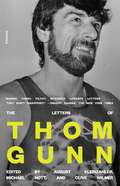
By Thom Gunn. 2021
The Letters of Thom Gunn presents the first complete portrait of the private life, reflections, and relationships of a maverick…
figure in the history of British and American poetry. “I write about love, I write about friendship,” remarked Thom Gunn. “I find that they are absolutely intertwined.” These core values permeate his correspondence with friends, family, lovers, and fellow poets, and they shed new light on “one of the most singular and compelling poets in English during the past half-century” (Hugh Haughton, The Times Literary Supplement). The Letters of Thom Gunn, edited by August Kleinzahler, Michael Nott, and Clive Wilmer, reveals the evolution of Gunn’s work and illuminates the fascinating life that informed his poems: his struggle to come to terms with his mother’s suicide; settling in San Francisco and his complex relationship with England; his changing relationship with his life partner, Mike Kitay; the LSD trips that led to his celebrated collection Moly (1971); and the deaths of friends from AIDS that inspired the powerful, unsparing elegies of The Man with Night Sweats (1992).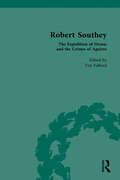
By Tim Fulford. 2025
First published in 1821, Robert Southey’s 'Expedition of Orsua and the Crimes of Aguirre' is the first account in English…
of one of the earliest expeditions down the Amazon River, made in the years 1560-1 by a renegade band of Spanish conquistadors in search of El Dorado.This sensational story features mutiny, madness, and murder– the total breakdown of order among power-hungry colonists as they are carried further and further into the immense jungle and further and further from European settlements. This edition contains a comprehensive critical apparatus that make sense of the major issues posed by the text and show how it contributes to studies of Southey, of colonialism and of travel/exploration writing in the nineteenth century more widely. The volume features a critical and contextual introduction, which sets out the origins and composition of the text together with its publication history, as well as offer a carefully considered view of the interplay between it and other narratives of exploration of the period, bringing into view the wide array of sources and influences Southey drew from.This book will be of interest to students and scholars of 19th century literature and history.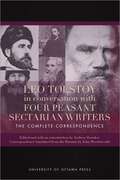
By Andrew Donskov. 2019
Andrew Donskov takes a critical look not only at Tolstoy’s attitude towards the peasant class he so often championed for…
their simple ways and freedom from upper-class sophistication and pretentiousness, but more importantly, gives voice to representatives of the peasant class itself. The theme of the peasantry is central throughout most of Tolstoy’s long career. His obsession with this class is seen not just as a matter of social or humanitarian concern, but as a response to the questions of “how to live a good life” and “what is the meaning of life that an inevitable death will not destroy?” These questions plagued him his entire life. The letters he exchanged with the four major peasant sectarian writers (Bondarev, Zheltov, Verigin, and Novikov) reveal that Tolstoy was matched as a profound thinker by his correspondents, as they converse on religious-moral questions, the meaning of life and how one should strive to find it, and on a wide array of burning social and personal problems. Reading through the analysis and the extensively annotated letters as a unified whole, elucidates the progressive development of the ideas they shared (and where these diverged) and which guided Tolstoy’s and his correspondents’ lives. Juxtaposing Tolstoy’s letters with those of his four sectarian correspondents makes them even more significant as it shows them in their original context – a dialogue, or conversation. Also, with the aim to present the conversation in an even broader context, Andrew Donskov briefly discusses Tolstoy’s relationship with peasants in general as well as with each of the four individual writers in particular. In addition, he provides a background sketch of two major religious groups, namely the Doukhobors and the Molokans, both of which still claim sizeable populations of followers in North America today. Originally published in 2008 by the Slavic Research Group at the University of Ottawa under the title Leo Tolstoy and Russian peasant sectarian writers: Selected correspondence, the expanded University of Ottawa Press edition includes 44 letters never published in English, out of the total 155 letters. Correspondence translated by John Woodsworth. Published in English.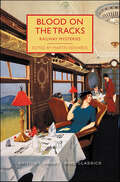
By Martin Edwards. 2018
“[An] entertaining railway-themed anthology . . . The perfect volume for fans of short, high-quality, fair-play detective fiction.” —Publishers WeeklyDiscover…
the captivating treasures buried in the British Library's archives. Largely inaccessible to the public until now, these enduring classics were written in the golden age of detective fiction.“Never had I been given a tougher problem to solve, and never had I been so utterly at my wits' end for a solution.”A signalman is found dead by a railway tunnel. A man identifies his wife as a victim of murder on the underground. Two passengers mysteriously disappear between stations, leaving behind a dead body.Trains have been a favourite setting of many crime writers, providing the mobile equivalent of the “locked-room” scenario. Their enclosed carriages with a limited number of suspects lend themselves to seemingly impossible crimes. In an era of cancellations and delays, alibis reliant upon a timely train service no longer ring true, yet the railway detective has enjoyed a resurgence of popularity in the twenty-first century.Both train buffs and crime fans will delight in this selection of fifteen railway-themed classic mysteries, featuring some of the most popular authors of their day alongside less familiar names. This is a classic short story collection to beguile even the most wearisome commuter.These fascinating mystery stories are:For fans of Agatha Christie and Anthony HorowitzPerfect for readers of classic crime fiction and golden-age murder mysteries“A handy book to have around when you want to read a clever mystery but time doesn't permit you to get engrossed in a novel.” —Popular Culture Association
By Calvin Trillin. 2011
""Trillin on Texas" gathers some of the author's best writing on subjects near to his heart--politics, true crime, food, and…
rare books, among them--which also have a Texas connection. Sure to entertain Texans and other readers alike, Trillin proves once again that he is one of America's shrewdest observers and wittiest writers." -- publisher marketing. Adult. Some strong language. Some violence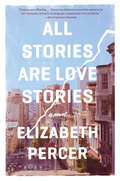
By Elizabeth Percer. 2016
"In this thoughtful, mesmerizing tale with echoes of Station Eleven, the author of An Uncommon Education follows a group of…
survivors thrown together in the aftermath of two major earthquakes that strike San Francisco within an hour of each other--an achingly beautiful and lyrical novel about the power of nature, the resilience of the human spirit, and the enduring strength of love. On Valentine's Day, two major earthquakes strike San Francisco within the same hour, devastating the city and its primary entry points, sparking fires throughout, and leaving its residents without power, gas, or water. Among the disparate survivors whose fates will become intertwined are Max, a man who began the day with birthday celebrations tinged with regret; Vashti, a young woman who has already buried three of the people she loved most. but cannot forgot Max, the one man who got away; and Gene, a Stanford geologist who knows far too much about the terrifying earthquakes that have damaged this beautiful city and irrevocably changed the course of their lives. As day turns to night and fires burn across the city, Max and Vashti--trapped beneath the rubble of the collapsed Nob Hill Masonic Auditorium--must confront each other and face the truth about their past, while Gene embarks on a frantic search through the realization of his worst nightmares to find his way back to his ailing lover and their home"-- Provided by publisher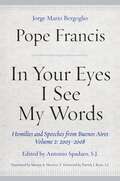
In Your Eyes I See My Words, Volume 2 contains Pope Francis’s homilies and speeches spanning from 2005 to 2008.…
Continuing what began in the first volume of this three-volume publication, Volume 2 shows Archbishop Bergoglio’s growth as a pastor and a theologian/scholar in the midst of his people. At the same time, it shows him emerging as an international voice calling for changes in the way the Church carries out its ministry and its educational task on behalf of children, youth, adults, and church ministers. In his homilies from Christmas, Easter, and especially in his response to the tragic fire and deaths of 194 people at the nightclub Republica Cromañon, we see Bergoglio speak passionately to his parishioners, challenging them with equal portions of tenderness and righteous anger. Perhaps uniquely, we also watch as his audiences, prominence, and influence grow globally, foreshadowing who he will become in 2013 when he is elected Pope.On the larger national and international scale, Bergoglio addresses various conferences, such as the Argentina Press Association and the Episcopal Conference of Argentina of which he was elected President in 2005 and served the maximum possible term of six years. We see and read as his work takes him outside his country to Rome (2007) at the Pontifical Commission for Latin America; to Brasil (2007), where his presentation on the Crisis of Civilization and Culture at the Fifth CELAM Conference ends up shaping much of the Aparecida Conclusions; and finally, to Quebec (2008) as he speaks at the Forty-Ninth International Eucharistic Congress.All told, In Your Eyes I See My Words, Volume 2 is a glimpse into a period of time in which Archbishop Bergoglio grows immensely in thought, reflection, and action, laying the groundwork for the mature, thoughtful, and beloved Pope Francis he has come to be known as around the world.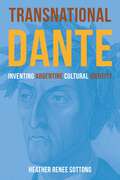
By Heather Renee Sottong. 2025
Opens the field of Dante Studies to further transnational studies of the Divine Comedy’s circulation, translation, and global influenceThis fascinating…
book examines how Dante was repurposed by Argentine politicians and authors who were concerned with the construction of Argentine national identity in the late nineteenth and early twentieth centuries. Sottong’s work is informed by the theories of Eric Hobsbawm, Benedict Anderson, and Nicolas Shumway, who coined the concepts of “invented traditions,” “imagined communities,” and “guiding fictions,” respectively. Sottong has applied these notions to the case of Argentina, which, after the War of Independence from Spain (1810–1818), had to develop its own national cultural identity.In this volume, she investigates Dante’s transnational influence in Argentina: Why did Argentine authors consistently call upon Dante in their attempts to develop Argentine literature? What are the textual and thematic characteristics of Dante’s Divine Comedy that make it an ideal vehicle for literary appropriation? What are the historical and cultural factors that account for Dante’s enduring popularity in Italy and beyond? How did the strong presence of Italians in Argentina influence cultural production in the developing nation? And how are the re-writings of Dante in the Argentine canon in dialogue with one another?What Sottong found, remarkably, was that rewriting Dante was a way for Argentine authors to voice their views on the direction that should be taken to develop Argentine letters; Dante became something of a literary guide as Argentine intellectuals navigated the complex labyrinth of their national identity. The consistent rewriting of the Divine Comedy in the Argentine context testifies to the fact that great works of literature can be revived during different periods and even reappropriated by various peoples to foster mythologies of inclusion or exclusion related to national identity.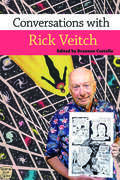
By Brannon Costello. 2025
From his roots in underground comics to his high-profile runs on mainstream characters, Rick Veitch (b. 1951) has carved out…
a career unlike anyone else’s. Collecting thirteen interviews—including three published here for the first time—Conversations with Rick Veitch offers a wealth of insight not only into the development of Veitch’s graphic innovations and metaphysical explorations, but also into the upheavals and transformations of American comics from the 1970s to today. In acclaimed comics such as The Maximortal, Army@Love, and Can’t Get No, Veitch employs a style that synthesizes Jack Kirby at his most cosmic, the mind-bending graphic sensibility of European innovators such as Jean (Moebius) Giraud and Philippe Druillet, and the brass-tacks realism of classic war cartoonists such as John Severin and Russ Heath. His comics defamiliarize popular genres—especially superheroes, war stories, and science fiction—with his philosophical musings and pointedly satirical political perspective. Yet Veitch’s capacious mind reaches beyond these familiar genres, too, as his long-running autobiographical dream comic Roarin’ Rick’s Rare Bit Fiends attests. Ranging across topics such as his early days at the Joe Kubert School, the controversial end of his Swamp Thing run, his muckraking work as a comics journalist, and his educational comics publishing venture, Eureka Comics, the interviews collected here reveal Veitch to be both a shrewd observer of the pitfalls of the marketplace and an eloquent spokesman for the boundless potential of creativity. A comics maker since childhood and a fierce advocate of creator’s rights and the possibilities of self-publishing, Veitch knows all too well the many persistent obstacles to creating comics that challenge readers instead of condescending to them. Yet Veitch remains optimistic about the potential of comics. According to Veitch, comics “might be the form of the future.” If that’s the case, then his work is a map to that future.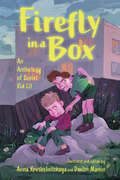
By Anna Krushelnitskaya, Dmitri Manin. 2025
Contributions by Marina Balina, Sibelan Forrester, Anna Krushelnitskaya, Dmitri Manin, Svetlana Maslinskaya, Ainsley Morse, and Serguei Alex. OushakineIn Firefly in…
a Box: An Anthology of Soviet Kid Lit, translators Anna Krushelnitskaya and Dmitri Manin present a hybrid scholarly and literary volume of popular Russian-language Soviet children’s texts alongside essays that outline the significance and meanings behind these popular texts. The selection features both poetry and short prose, all of which are instantly recognizable to a Soviet native, and all of which hold cultural currency, potency, and valence similar to popular children’s literature in the United States, such as Green Eggs and Ham, Curious George, or Make Way for Ducklings. These texts have either never been translated into English before or appear in all-new translations, literary rather than literal; the featured original Soviet illustrations are reprinted for the English-reading market for the first time. Alongside the translations themselves is a scholarly component that guides Anglophone readers to experience mainstays of Soviet children’s writing. Essayists investigate literary material and perspectives using a broad range of approaches and methodologies applied to Soviet children’s literature. Topics include the Soviet literary canon, the beginning and evolution of Soviet children’s literature in the 1920s and 1930s, interactions between literary texts for children and folklore, and the interplay between Soviet and British children’s poetry.
By David Grann. 2011

By Jessica Fisher. 2024
Jessica Fisher brings "the faraway close," through ruthless yet tender interrogations of possibility and permanence. Set against the backdrop of…
the fallen empire of Rome, Daywork takes its title from the giornata the name in fresco painting for the section of wet plaster that can be painted in a single day, where each "day" is marked by the hidden seams in a finished painting. In a voice that is as poised as it is unmistakably urgent, Fisher aims to uncover what adheres against the fabric of history, and what becomes effaced over time. Her search leads her to discover signs of ruin of a different kind, and her poems begin to coalesce around a single perilous realization: that time is not merely an agent of erasure. Time is also a tether, rendering violence, beauty, grief, and art separate merely by a matter of days. "So you see once again," she writes, "violence is to beauty / as the warp to the weft / always somewhere beneath." Like the fresco itself, Daywork is committed to a time- and site-specific art, and to the daily work of creation. At once an elegiac meditation and a brave unearthing, this book expertly discerns the monumentalizing portrayals of history and its violences, while boldly illuminating other crucial accounts of everyday existence. Adult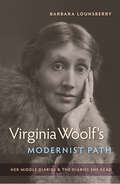
By Barbara Lounsberry. 2016
Choice Outstanding Academic Title In this second volume of her acclaimed study of Virginia Woolf 's diaries, Barbara Lounsberry traces…
the English writer's life through the thirteen diaries she kept from 1918 to 1929--what is often considered Woolf’s modernist "golden age." During these interwar years, Woolf penned many of her most famous works, including Mrs. Dalloway, To the Lighthouse, Orlando, and A Room of One's Own. Lounsberry shows how Woolf's writing at this time was influenced by other diarists--Anton Chekhov, Katherine Mansfield, Jonathan Swift, and Stendhal among them--and how she continued to use her diaries as a way to experiment with form and as a practice ground for her evolving modernist style.Through close readings of Woolf 's journaling style and an examination of the diaries she read, Lounsberry tracks Woolf 's development as a writer and unearths new connections between her professional writing, personal writing, and the diaries she was reading at the time. Virginia Woolf's Modernist Path offers a new approach to Woolf 's biography: her life as she marked it in her diary from ages 36 to 46.